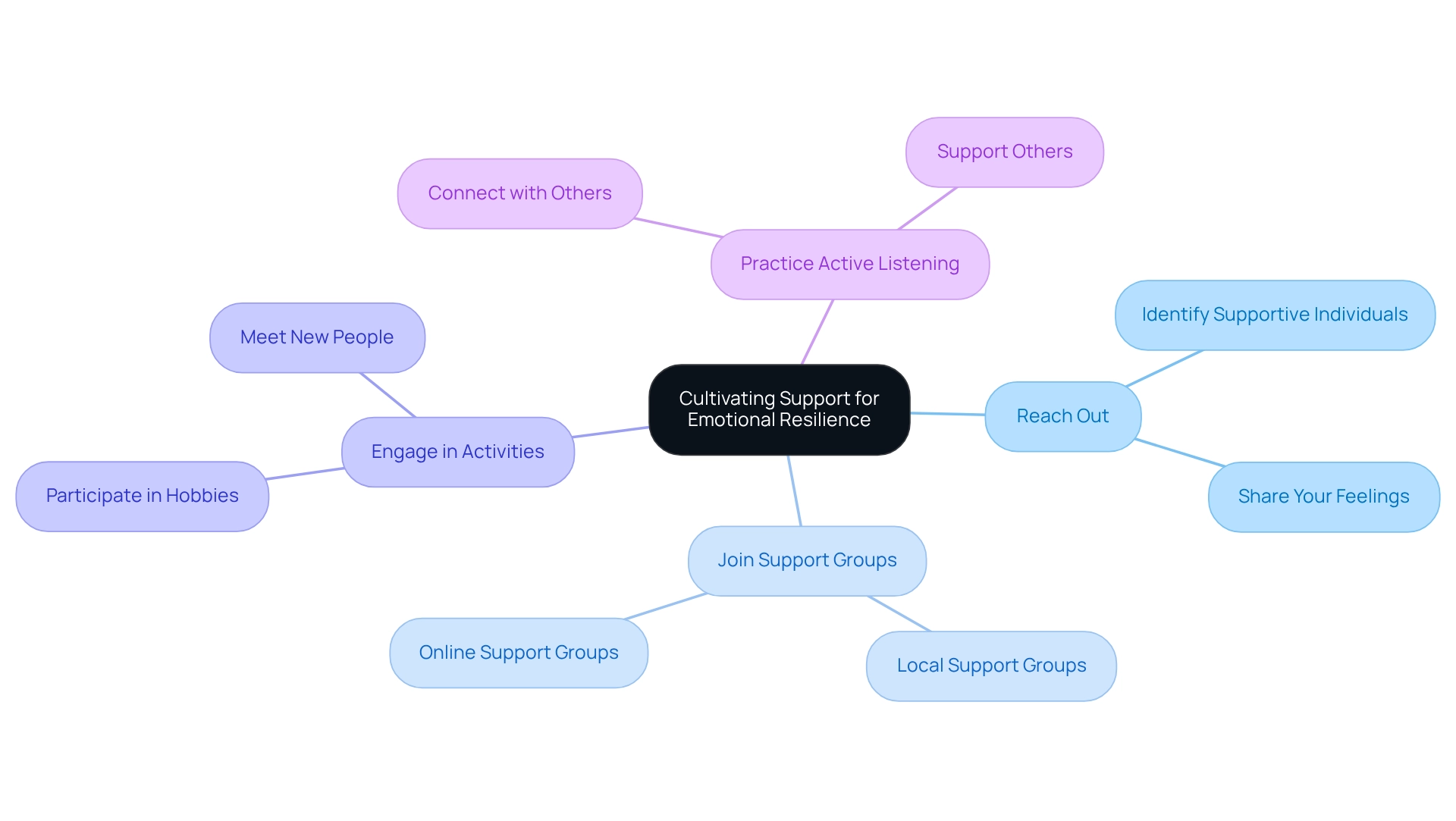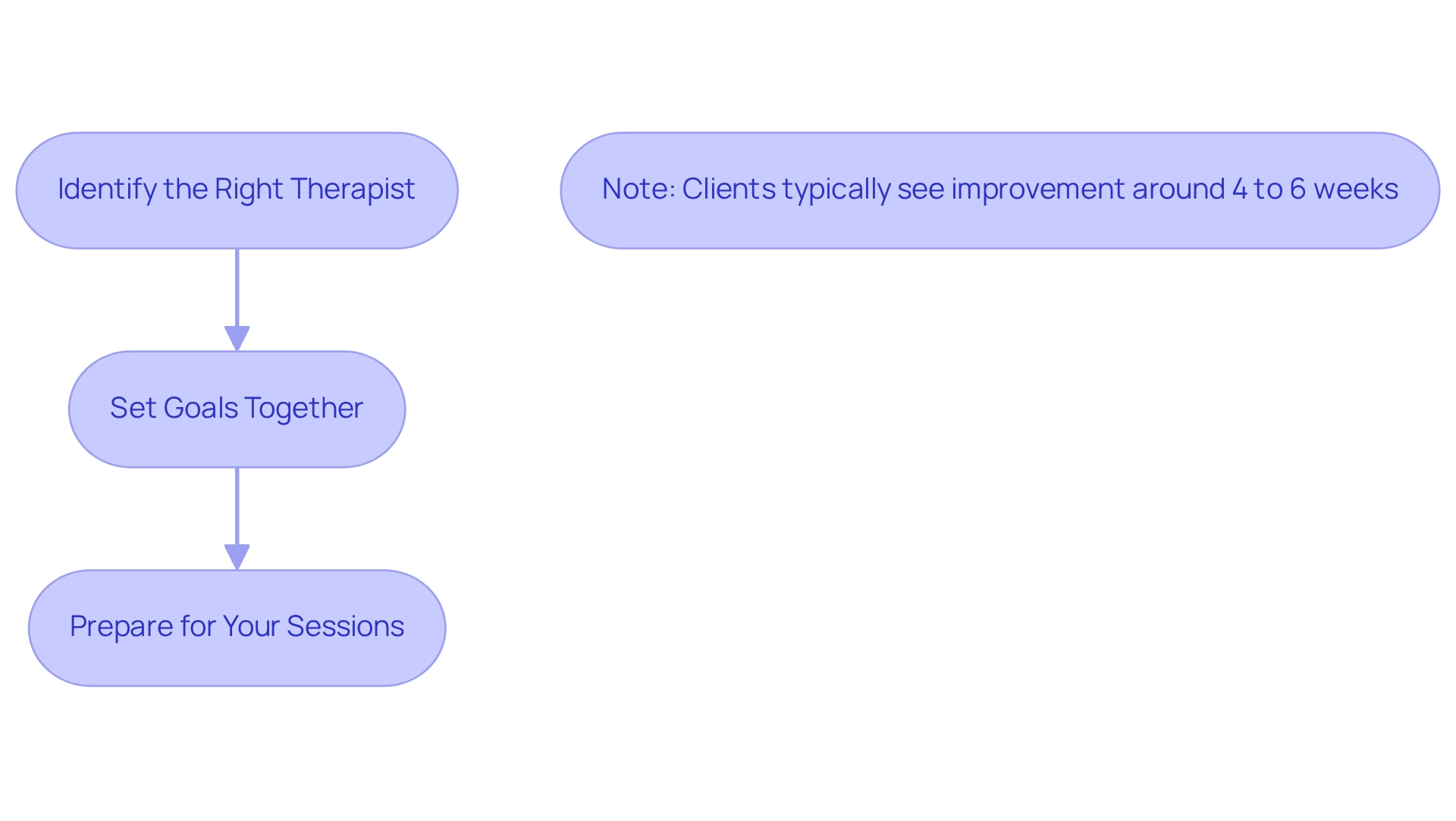Overview
Managing anxiety effectively and alleviating nervousness can be achieved through four key steps that nurture your well-being:
- Identify your anxiety triggers.
- Implement practical techniques such as breathing exercises and mindfulness.
- Cultivate a supportive network of friends and family.
- Seek professional guidance when necessary.
As we explore these steps, it's important to recognize the specific strategies that can help you identify symptoms and triggers, as well as practical methods to reduce anxiety.
Building emotional resilience through social connections and therapy is vital, and remember, you are not alone in this journey. Have you ever felt overwhelmed by your past? It's okay to seek help and take steps toward healing. Together, we can navigate these challenges with compassion and understanding.
Introduction
In a world where anxiety often feels like an unwelcome companion, have you ever paused to consider what triggers those feelings? Understanding these triggers and symptoms is the first step toward reclaiming your peace of mind. Anxiety can manifest in various ways, from the physical sensations of a racing heart to the emotional turmoil of excessive worry. This article invites you to explore the complexities of anxiety, offering:
- Practical techniques for management
- The importance of building a supportive network
- The transformative role of professional therapy
By gently identifying your personal triggers and implementing effective coping strategies, you can embark on a journey towards emotional resilience and well-being.
Understand Anxiety: Recognizing Its Triggers and Symptoms
Anxiety can manifest in various ways, including physical symptoms like increased heart rate, sweating, and muscle tension, as well as emotional symptoms such as excessive worry and fear. Have you ever felt overwhelmed by your anxiety? To effectively manage these feelings and understand how not to be nervous, it is essential to identify personal triggers, which may include stressful situations, specific environments, or even certain thoughts. At The Emerald Couch, we understand that the journey to wellness is unique for each individual. Therapy duration can vary based on personal needs and goals, and most clients begin to feel some improvement within 4 to 6 weeks. We tailor our approach to your specific circumstances, ensuring you receive the support you need. We also offer virtual appointments for those who may need them.
-
Identify Indicators: Keeping a journal can be a helpful way to note when you feel anxious and what signs you experience. Common symptoms include:
- Rapid heartbeat
- Shortness of breath
- Restlessness
- Difficulty concentrating
-
Recognize triggers to understand how not to be nervous by reflecting on situations that lead to stress. Triggers can be:
- Social interactions
- Work-related stress
- Major life changes
-
Educate Yourself: Understanding the nature of distress can demystify the experience. Consider reading articles, attending workshops, or consulting with experts to learn more about stress disorders and their effects on mental health. At The Emerald Couch, we emphasize the importance of finding the right therapist, as many individuals go through several before discovering the right fit. Our specialists are dedicated to creating a safe and trusting environment, allowing you to share your concerns at your own pace. This personalized support is crucial for trauma and stress recovery, ensuring that you feel comfortable and understood throughout your therapeutic journey. As you advance, we will collaborate to create approaches that assist you in managing stress efficiently.

Implement Techniques: Practical Steps to Reduce Anxiety
Apply these practical techniques to learn how not be nervous and effectively handle stress. Here are some strategies that can truly make a difference:
-
Breathing Exercises: Have you ever felt overwhelmed and needed a moment to regain your calm? Practicing deep breathing techniques is a way to learn how not be nervous and can help soothe your nervous system. Try the 4-7-8 method:
- Inhale for 4 seconds
- Hold for 7 seconds
- Exhale for 8 seconds
Additionally, consider practicing mindful breathing by focusing on the sensations of your breath as it flows in and out. This simple act can ground you in the present moment, providing a gentle refuge from stress.
-
Mindfulness and Meditation: Engaging in mindfulness practices can be a wonderful way to stay present. Techniques such as breath awareness, body scans, and mindful observation can be particularly effective. For instance, during a body scan, systematically focus on each part of your body, noticing any sensations without judgment. Mindful observation involves choosing an object to focus on, observing its details without distraction. Apps like Headspace or Calm can guide you through meditation sessions, making this practice more accessible.
-
Physical Activity: Did you know that regular exercise can alleviate stress? Aim for at least 30 minutes of moderate exercise most days of the week, whether it’s walking, jogging, or practicing yoga. You can also incorporate mindfulness during these activities by paying attention to how your body feels as you move, creating a deeper connection with yourself.
-
Journaling: Writing down your thoughts and feelings can be a powerful way to process emotions and alleviate stress. Have you considered focusing on gratitude or positive experiences to shift your mindset? Including mindful observation in your journaling can enhance this practice; take a moment to notice your environment and contemplate the specifics you perceive. By integrating these mindfulness strategies into your daily habits, you can boost your mental well-being and learn how not be nervous when effectively handling stress. Remember, seeking support is a sign of strength, and these practices can guide you on your journey towards healing.

Cultivate Support: Building a Network for Emotional Resilience
Cultivating a support network can significantly enhance your ability to manage anxiety, especially for overachievers who often struggle with prioritizing their needs. Have you ever felt overwhelmed by your past? Building these connections can be a vital step toward healing.
-
Reach Out: Identify friends, family, or colleagues who are supportive. Don’t hesitate to share your feelings with them; this openness can foster trust and understanding, creating a safe space for you to express yourself.
-
Join Support Groups: Consider joining a local or online support group where you can connect with others facing similar challenges. This can provide a sense of community and understanding, crucial for those navigating trauma and anxiety. In addition to this, engaging with others who share your experiences can be incredibly comforting.
-
Engage in Activities: Participate in social activities or hobbies that interest you. This can assist you in meeting new individuals and enhancing current relationships, forming a network that bolsters your emotional resilience. Remember, every connection you make can be a step toward feeling more supported.
-
Practice Active Listening: When talking to others, practice active listening. This not only helps you connect but also allows you to support others in their struggles, reinforcing a non-judgmental environment that is essential for healing. As we explore this further, consider how these interactions can enrich your life and contribute to your journey of self-care.

Seek Professional Guidance: The Role of Therapy in Overcoming Anxiety
Seeking professional guidance can be a transformative step in managing stress, especially for trauma survivors. Have you ever felt overwhelmed by your past? Approaching counseling at The Emerald Couch can be a nurturing experience that supports your healing journey.
-
Identify the Right Therapist: It’s crucial to find a therapist who specializes in mood disorders, like those at The Emerald Couch. Our dedicated team offers personalized psychotherapy services, focusing on trauma and anxiety, utilizing effective methods such as cognitive-behavioral techniques (CBT), and we will discuss how not to be nervous before your first session by encouraging you to jot down your symptoms, triggers, and any coping strategies you’ve tried. This preparation will help your therapist understand your unique circumstances more deeply and tailor the treatment to meet your individual needs.
-
Set Goals Together: Collaborate with your therapist to establish achievable objectives for your treatment sessions. At The Emerald Couch, we emphasize the importance of collaborative goal-setting, whether it’s about developing effective coping strategies or learning how not to be nervous in specific situations. The more open you are, the more effective the therapy will be. Remember, many clients begin to feel better or notice some improvement around 4 to 6 weeks as we work together towards your wellness goals. Additionally, we invite you to take advantage of our free 30-minute consultation, designed to help you better understand your needs and discover how we can support you on your path to healing.

Conclusion
Understanding anxiety is crucial for anyone looking to reclaim their peace of mind. Have you ever felt overwhelmed by your past? By identifying personal triggers and recognizing the symptoms—whether they are physical or emotional—individuals can take the first steps toward effective management. This article outlines practical techniques such as:
- Breathing exercises
- Mindfulness
- Physical activity
- Journaling
All of which serve to ground oneself in the present and alleviate anxiety.
Building a supportive network is equally vital in managing anxiety. By reaching out to friends, joining support groups, and engaging in meaningful activities, individuals can create a community that fosters emotional resilience. Active listening and open conversations can strengthen these connections, providing a safe space for sharing and healing.
In addition to this, seeking professional guidance through therapy can be transformative for those struggling with anxiety. Finding the right therapist and setting clear goals can pave the way for meaningful progress. With tailored approaches and a focus on collaboration, therapy becomes a personalized journey toward wellness.
In conclusion, navigating anxiety is a multifaceted process that involves self-awareness, support, and professional guidance. By implementing these strategies, individuals can not only manage their anxiety but also cultivate resilience and foster a deeper understanding of their emotional health. The journey may be challenging, but with the right tools and support, it is entirely possible to reclaim a sense of peace and well-being.
Frequently Asked Questions
What are the physical symptoms of anxiety?
Physical symptoms of anxiety can include increased heart rate, sweating, and muscle tension.
What are the emotional symptoms of anxiety?
Emotional symptoms of anxiety often involve excessive worry and fear.
How can I effectively manage my anxiety?
To effectively manage anxiety, it is essential to identify personal triggers, which may include stressful situations, specific environments, or certain thoughts.
How long does therapy typically take to show improvement?
Most clients begin to feel some improvement within 4 to 6 weeks of therapy, though the duration can vary based on personal needs and goals.
What methods can help identify anxiety indicators?
Keeping a journal can be helpful to note when you feel anxious and what signs you experience, such as rapid heartbeat, shortness of breath, restlessness, and difficulty concentrating.
What are common triggers of anxiety?
Common triggers of anxiety can include social interactions, work-related stress, and major life changes.
How can I educate myself about anxiety and stress disorders?
You can educate yourself by reading articles, attending workshops, or consulting with experts to learn more about stress disorders and their effects on mental health.
Why is finding the right therapist important?
Finding the right therapist is important because many individuals go through several before discovering a suitable fit. A good therapist creates a safe and trusting environment, allowing you to share your concerns at your own pace.
What is the approach taken by The Emerald Couch for therapy?
The Emerald Couch tailors its approach to each individual's specific circumstances, ensuring personalized support crucial for trauma and stress recovery.




